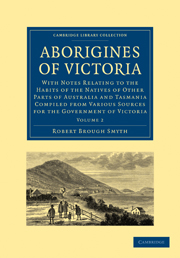 Aborigines of Victoria
Aborigines of Victoria Published online by Cambridge University Press: 05 August 2011
PHYSICAL CHARACTER
The natives of Tasmania differed in appearance from the people of the continent; but, as has been remarked of the people of the continent, they were not all alike, and there is reason to believe that the members of some tribes were scarcely distinguishable from the Australians.
Cook saw the Tasmanians in 1777, “They were quite naked,” he tells us, “and wore no ornaments, unless we consider as such, and as a proof of their love of finery, some large punctures or ridges raised on different parts of their bodies, some in straight and others in curved lines. They were of the common stature, but rather slender. Their skin was black, and also their hair, which was as woolly as that of any native of Guinea; but they were not distinguished by remarkably thick lips nor flat noses. On the contrary, their features were far from being disagreeable. They had pretty good eyes, and their teeth were tolerably even, but very dirty. Most of them had their hair and beards smeared with a red ointment, and some had their faces also painted with the same composition.”
“The Aborigines of Van Diemen's Land,” according to Mr. R. H. Davies, “are a full average height, very sinewy and wiry. Stout, muscular men occur but rarely; this is in accordance with their habits, in which activity rather than strength is called into action.
To save this book to your Kindle, first ensure [email protected] is added to your Approved Personal Document E-mail List under your Personal Document Settings on the Manage Your Content and Devices page of your Amazon account. Then enter the ‘name’ part of your Kindle email address below. Find out more about saving to your Kindle.
Note you can select to save to either the @free.kindle.com or @kindle.com variations. ‘@free.kindle.com’ emails are free but can only be saved to your device when it is connected to wi-fi. ‘@kindle.com’ emails can be delivered even when you are not connected to wi-fi, but note that service fees apply.
Find out more about the Kindle Personal Document Service.
To save content items to your account, please confirm that you agree to abide by our usage policies. If this is the first time you use this feature, you will be asked to authorise Cambridge Core to connect with your account. Find out more about saving content to Dropbox.
To save content items to your account, please confirm that you agree to abide by our usage policies. If this is the first time you use this feature, you will be asked to authorise Cambridge Core to connect with your account. Find out more about saving content to Google Drive.